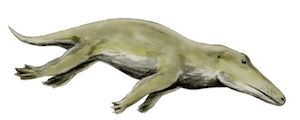866-295-4143, fbns@wayoflife.org
“Darwinism does not look you squarely in the eye” (Michael Pitman, Adam and Evolution, p. 217).
“When our leading scientists have to resort to the sort of distortion that would land a stock promoter in jail, you know they are in trouble” (Phillip Johnson, The Wall Street Journal, 1999).
“Forgeries and frauds are not all that uncommon in the science world” (Paul Chambers, Bones of Contention, p. 248).
“I believe that one day the Darwinian myth will be ranked the greatest deceit in the history of science” (Soren Lovtrup, Darwinism: The Refutation of a Myth).
“The impression that scientists think rationally and fairly is a simplistic myth. The fact is they are subject to the same human failings as the rest of us. Looking inside the ivory towers we find the familiar power establishments, personality conflicts, and intellectual blind spots brought about by philosophical presuppositions” (Ian Taylor, In the Minds of Men, p. 280).
“Within the English-speaking world, Darwin’s theory of evolution remains the only scientific theory to be widely championed by the scientific community and widely disbelieved by everyone else. No matter the effort made by biologists, the thing continues to elicit the same reaction it has always elicited: You’ve got to be kidding, right?” (David Berlinski, The Devil’s Delusion, p. 186).

Art has been used for decades to portray the supposed evolution of the whale from a small land creature.
Darwin imagined that the whale evolved from the bear, but it is more popular today to claim that it evolved from an extinct wolf-like creature.
In 1994, newspapers announced, “Fossil Thought to Belong to Walking Whale--Creature May be Missing Link” (Cleveland Plain Dealer, Jan. 16 1994). This wolf-whale was dubbed Ambulocetus natans (“the whale that could walk and swim”). About the size of a male sea lion, this creature is thought to have been able to walk on land as well as swim in water. Of course, there are many living animals that can do that!
Kenneth Miller used this as a major icon for evolution in his anti-creationist book Finding Darwin’s God. He claimed that “the animal could move easily both on land and in water.”
As evidence he provided a drawing of a complete skeleton of Ambulocetus and a reconstruction of what the creature supposedly looked like (with stream-lined body, webbed feet, and a sort of Dolphin-looking head).
The problem is that the actual bones are few, so that Miller’s drawing of a complete skeleton is a fabrication. There are no bones of the pelvic girdle. As Jonathan Sarfati observes, “Without this, it’s presumptuous for Miller to make that proclamation” (Refuting Evolution 2, p. 138).
Another candidate for the alleged missing link between the land mammal and the whale is the Rodhocetus. It is depicted in museums and textbooks as a creature that has some whale-like features such as a long whalish snout, a whalish tale or fluke, and flippers, but with four legs-- two short ones in the back and longer ones in the front.
While filming for the video documentary Evolution: The Great Experiment, Dr. Carl Werner noticed a discrepancy at the University of Michigan fossil display between drawings of Rodhocetus and the actual fossils.
In particular, there are no fossils for the fluke or for the flippers, the very things that are used as evidence that this creature is a missing link in the evolution of the whale.
In an interview, Dr. Phil Gingerich, the scientist responsible for the discovery of and reconstruction of Rodhocetus, confirmed that the drawings are mere speculation. He said, “We don’t have the tail in Rodhocetus. We don’t know for certain whether it had a ball vertebrate indicating a fluke or not. So I SPECULATED that it might have had a fluke.”
Gingerich also acknowledged that the flippers were drawn without fossil evidence and that it is no longer believed that Rodhocetus had flippers. He said, “Since then, we have fond the forelimbs, the hands, and the front arms of Rodhocetus, and we understand that it doesn’t have the kind of arms that can be spread out like flippers are on a whale” (Evolution: The Grand Experiment, Vol. 1, p. 143).
Gingerich’s answers on camera were a bombshell, since even the museum’s own drawings still had flippers on the creature. He said:
“Since then we have found the forelimbs, the hands and arms of Rodocetus and we understand that it doesn’t have the kind of arms that can be spread out like flippers are on a whale. If you don’t have flippers, I don’t think you can have a fluked tail and really powered swimming. So I know doubt that Rodhocetus would have had a fluked tail.”
After showing the amazing interview with Dr. Gingerich, Evolution: The Grant Experiment concludes:
“Many experts consider whales to be the best fossil evidence for evolution but are unaware of these discrepancies. Opponents of evolution contend that whale evolution is nothing more than hopeful supposition. If museum diagrams are redrawn and corrected for various discrepancies opponents argue that whale evolution is nonexistent.”
It is important to note that the same documentary features interviews with evolutionary scientists who cite Rodhocetus as indisputable evidence for the evolution of the whale! For example, Dr. Taseer Hussain, paleontologist and professor of anatomy at Howard University and research associate at the Smithsonian National Museum of Natural History, said: “We have a complete, modern whale-type structure in Rodhocetus” (Evolution: The Grand Experiment, Vol. 1, p. 143).
Phil Gingerich, who has made a name for himself in the field of whale evolution, discovered another supposed missing link. This one, too, was found in Pakistan and is called PAKICETUS. It was trotted out in the 2001 PBS series “Evolution.” Though only a few skull fragments had been unearthed, it was claimed that the creature had “an inner ear like a whale’s” and it was depicted as swimming and catching fish underwater. On the flimsiest fossil “evidence,” Gingrich provided an illustration for schoolteachers of the Pakicetus swimming underwater like a whale, propelling itself with finnish-looking paws and a stumpy tail allegedly on its way to disappearing altogether (Jonathan Sarfarti, Refuting Evolution 2, p. 136). This was based on a few bone fragments!
When more bones of Pakicetus were unearthed, whale experts J. Thewissen, E. Williams, L. Roe, and S. Hussain stated in Nature magazine that it was strictly a land animal. “All the postcranial bones indicate that pakicetids were land mammals...” (“Skeletons of Terrestrial Cataceans and the Relationship of Whales to Artiodactyls,” Nature, Sept. 20, 2001, cited from Sarfati, Refuting Evolution 2, p. 137).
The new drawing of Pakicetus shows a creature very different than the one broadcast by PBS. It is a dog-like animal with a pointy snout and a long tail. No swimming underwater like a whale, no finnish-looking paws, no stumpy tail on the way to disappearing!
BASILOSAURUS is also used as a link in the chain of whale evolution. It was featured in the Discovery Channel’s series Walking with Dinosaurs and also in the National Geographic’s special report “Evolution of the Whale” (November 2001).
Basilosaurus was a large sea creature, for sure, but it was a reptile! In fact, the term “saurus” means lizard and is used for extinct dinosaur reptiles such as tyrannosaurus.
Career biology teacher Kenneth Poppe says:
“Its vertebral column, teeth, and nostrils much more resemble the seagoing dinosaurs called mosasaurus and plesiosaurus, and the small turbinates in the skull show it to be a cold-blooded creature. ... paleontologists are adamant the basilosaurus was not an intermediate in transition, but an established and permanent species in its own right that has no close ancestors or descendants. ... why is the reptile basilosaurus directly used to connect mammalian rodents to mammalian whales?” (Reclaiming Science from Darwinism, pp. 205, 208).
The “evidence” for whale evolution really boils down to two things, and both are nothing more than evolutionary assumptions.
First, there is homology, meaning the similarity between certain creatures that fit the evolutionary model of how whale evolution should have happened. A typical chart is the one at the Museum of Natural History at the University of Michigan, Ann Arbor. As the top is a dog-like creature and below that are three other creatures that grow progressively more similar in shape to a whale (though all the while being dramatically different from the whale). Even if these extinct creatures actually looked like the evolutionary drawings, which is highly doubtful, this does not add up to any evidence whatsoever for whale evolution. Another example is the whale exhibit at the Smithsonian Museum of Natural History. The ankle bone of a deer and the ankle bone of Rodhecetus are shown side-by-side with this explanation: “Similar ankle bone assemblies in this deer and in early whales strongly indicate their ancestral relationship.” Observe that they are assuming Rodhecetus is a type of whale, whereas there is absolutely no scientific evidence for this. They are also assuming that similarity in some structures is evidence of evolution, when this, too, has never been demonstrated.
The second evidence is the evolutionary naming system, whereby some extinct creatures are named “whales” and then used as evidence of whale evolution, but the naming is done on the sole basis of evolutionary assumptions. This is circular reasoning with a vengeance. Dr. Duane Gish, Ph.D. in biology from the University of California Berkeley says, “Frankly, I don’t know why they could call that creature a whale. I have never seen a walking whale, and I’ve never seen a pig that flies. These things just don’t exist. And the idea that there’s a whale that walked, well, we have marine organisms today--seals and these other creatures, sea lions and so forth--that can get up and maneuver on the land a little bit. But they’re made for that. They’re not intermediate between anything else at all” (quoted in Evolution: The Grand Experiment, Vol. 1, p. 138).
Evolutionary myths aside, consider how a wolf or any such creature would evolve into the 13 different families and 70 different species of whales.
Dr. Duane Gish mentions just a few of the enormous problems with this picture.
“Evolutionists are forced to believe that whatever the need may be, no matter how complex and unusual, random genetic errors were able to produce the structures required in a perfectly coordinated manner. ... It requires an enormous faith in miracles, where materialist philosophy actually forbids them, to believe that some hairy, four-legged mammal crawled into the water and gradually, over eons of time, gave rise to whales, dolphins, sea cows, seals, sea lions, walruses, and other marine mammals via thousands and thousands of random genetic errors. This blind hit and miss method supposedly generated the many highly specialized complex organs and structures without which these whales could not function, complex structures which in incipient stages would be totally useless and actually detrimental. Evolution theory is an incredible faith” (The Fossils Still Say No, pp. 206-208).
Consider the problem of the whale’s diving ability:
“Bottlenose dolphins easily dive to depths of nearly 1200 feet. The beaked whale can dive to a depth of over 1600 feet. The largest of the toothed whales, the sperm whale (length about 65 feet and weight about 120,000 pounds) dives easily to 3,000 feet and can dive even to a depth of almost 10,000 feet, nearly two miles. In order to withstand the enormous pressures at such great depths, which even at depths of about 3,000 feet reach pressures almost 100 times that at sea level, the cranial and auditory apparatus of the whale must be very specially modified, including greatly increased vascularization of the ear. The sperm whale has a huge chamber containing several hundred gallons of sperm oil, or spermaceti, which alters according to depth and temperature to permit adjustment in buoyancy. Before diving, this whale goes through a ten-minute breathing exercise in order for its muscles, blood, and lungs to store oxygen. Its blood contains 50% more hemoglobin than human blood, and while humans use only 10-20% of their breathed air for energy, this whale can utilize 80-90%. During a dive only 9% of its oxygen is derived from the lungs while 41% comes from blood and 50% from muscles and tissues.
“In order to help them ‘see’ at depths in the darkness, toothed whales are equipped with a sonar, or echolocation system. It is reported that they can hear sounds emitted under water from distances of sixty miles” (The Fossils Still Say No, p. 206).
Consider the problem of the change in the pelvis.
“One of the principal problems for Darwinians in whale evolution is constructing a pattern of events for the whale’s tail to emerge in small, naturally selected steps. The point is that the tail moves up and down, whereas in a land mammal it moves from side to side. This may sound a relatively small difference, but anatomically it is not. It means that somehow the whale’s ancestor had to get rid of its pelvis. ... According to Michael Pitman, a young Cambridge University biologist who has made a study of the problem, ‘every downward movement of such a tail would crush the reproductive opening of the creature against the back of the pelvis, causing pain and harm.’ ... Natural selection would work against, not for, such a change. So for the up-down action in whales to emerge, there simultaneously had to be random genetic changes that diminished the pelvis while allowing the tail to grow larger. Apart from the stupefyingly long odds against such a chain of events happening by chance, Pitman has concluded that there is a further anatomical objection. At a certain point in the supposed transitionary period, the hip bone would have been ‘too small to support the hind legs and yet too large to permit the musculature necessary to move the great tail of the whale’” (Francis Hitching, personal communication with Michael Pitman, The Neck of the Giraffe, p. 70).
Consider the problem of the baby whale.
“The babies of whales are born under water. If they were delivered in the way human babies are normally delivered--head first--they would not survive. All whales are born tail first. Baby whales must nurse under water. If they had to nurse in the usual way they would either drown or starve to death. No problem. The mammary glands of the mother whale are equipped with muscles which enables her to rapidly squirt the milk into the baby’s mouth under such pressure it would create a fountain above water six feet high. Her mother’s milk contains 42% fat and 12% protein, compared to 4.4% fat and 1% protein of human mother’s milk. A baby blue whale drinks about 200 pounds of milk daily, gaining about 175 pounds each day” (The Fossils Still Say No, p. 207).
The baby whale’s mouth fits snugly into his mother’s body so the sea water won’t get mixed with the milk, and its windpipe is elongated above the gullet so milk cannot flow into its lungs (David Watson, Myths and Miracles, pp. 27, 28).
“This design had to be perfect in both the mother and the baby whale from the very first time a baby whale was born and needed to nurse underwater.”
This is only a small part of what be required for a wolf-like creature to become a whale.
The evolution of the whale from any land creature is a whale of a tale!
- Receive these reports by email
- www.wayoflife.org
______________________
Sharing Policy: Much of our material is available for free, such as the hundreds of articles at the Way of Life web site. Other items we sell to help fund our expensive literature and foreign church planting ministries. Way of Life's content falls into two categories: sharable and non-sharable. Things that we encourage you to share include the audio sermons, O Timothy magazine, FBIS articles, and the free eVideos and free eBooks. You are welcome to make copies of these at your own expense and share them with friends and family. You may also post parts of reports and/or entire reports to websites, blogs, etc as long as you give proper credit (citation). A link to the original report is very much appreciated as the reports are frequently updated and/or expanded. Things we do not want copied and distributed are "Store" items like the Fundamental Baptist Digital Library, print editions of our books, electronic editions of the books that we sell, the videos that we sell, etc. The items have taken years to produce at enormous expense in time and money, and we use the income from sales to help fund the ministry. We trust that your Christian honesty will preserve the integrity of this policy. "For the scripture saith, Thou shalt not muzzle the ox that treadeth out the corn. And, The labourer is worthy of his reward" (1 Timothy 5:18). Questions? support@wayoflife.org
Goal:Distributed by Way of Life Literature Inc., the Fundamental Baptist Information Service is an e-mail posting for Bible-believing Christians. Established in 1974, Way of Life Literature is a fundamental Baptist preaching and publishing ministry based in Bethel Baptist Church, London, Ontario, of which Wilbert Unger is the founding Pastor. Brother Cloud lives in South Asia where he has been a church planting missionary since 1979. Our primary goal with the FBIS is to provide material to assist preachers in the edification and protection of the churches.
Offering: Offerings are welcome if you care to make one. If you have been helped and/or blessed by our material offerings can be mailed or made online with with Visa, Mastercard, Discover, or Paypal. For information see: www.wayoflife.org/about/makeanoffering.html.





